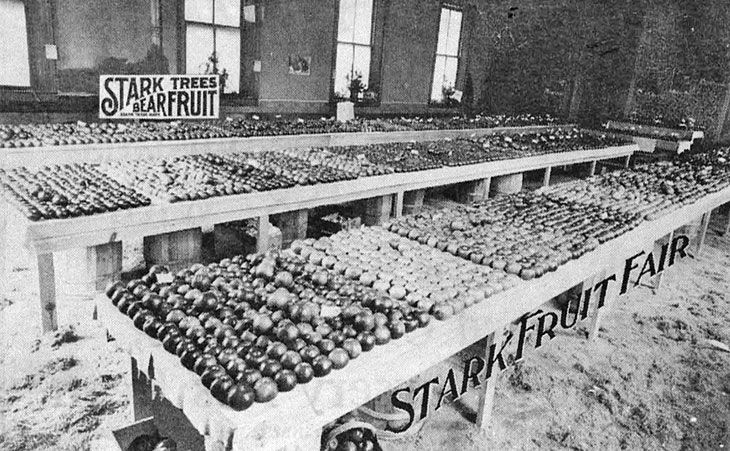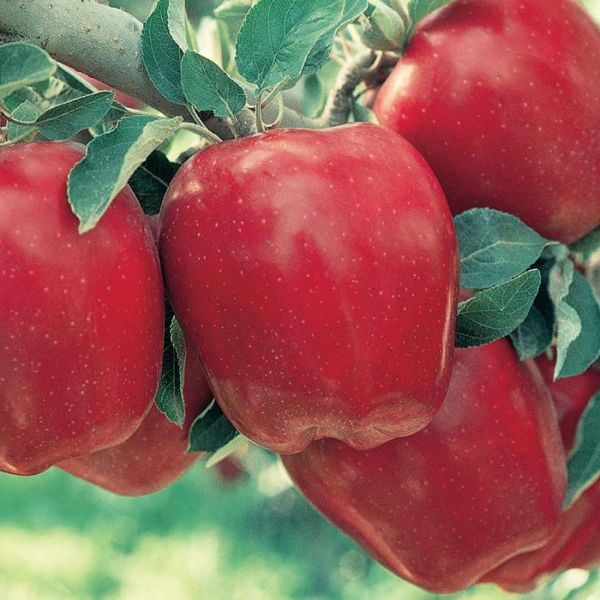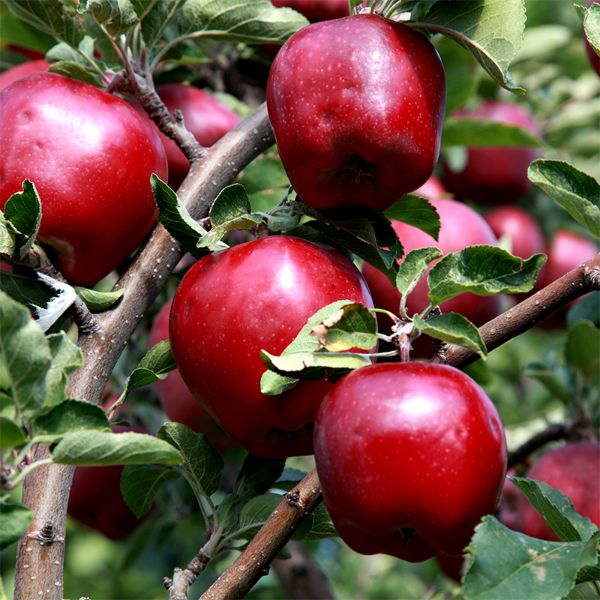A Delicious Discovery: Red Delicious Apple
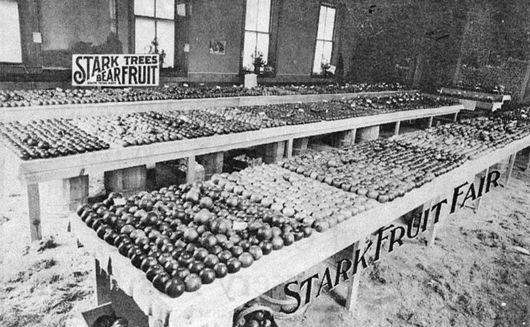
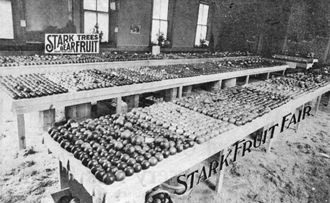
Back in 1893, the best-known and the most widely-planted apple was 'Ben Davis'. It was a hardy apple that stood up to tough winters, would grow almost anywhere and did not bruise easily, but it had a rather significant drawback: it didn't taste very good. Clarence Stark knew well the shortcomings of Ben Davis apples. Unable to discourage farmers from raising them, he decided the only alternative was to find a better apple himself.

And so intrepid Clarence literally got on his horse, and traveled through the Ozarks, studying varieties all along the way. He returned with several good ones — 'Senator', 'King David' and 'Champion' — but the elusive flavor he sought was not among them. Never easily satisfied, Clarence continued his search for a more perfect apple.
But how to find it? He couldn't keep traveling all over the country on horseback, and jet airliners hadn't been invented yet. Then the idea struck him: have growers send in samples, and conduct a contest to determine the best variety! Not only would new apples come to Clarence, but he could also draw attention to Stark Bro's with ads for the contest.
And so the very first International New Fruit Show was held, with great fanfare, in 1893. Professor Henry E. Van Deman, then the official USDA Chief Pomologist, was brought to Louisiana from Washington, D.C. to be a judge. Invitations were sent to apple growers all over the country, asking them to send in their varieties for the contest. Hundreds of entries were received from 27 states.
One of those growers was Jesse Hiatt, a good Quaker man. Some years ago on his Peru, Iowa farm, he discovered a chance seedling in his orchard of 'Yellow Bellflower' trees. He chopped it down, but the next season, it sprang back up. He chopped it down a second time. It came back again.
"If thee must grow," he told the stubborn sprout, "thee may," goes the story. Some years later, Hiatt's tree bore its first fruit. The apple was an elongated globe with red-and-gold striped skin, crisp flesh and a five-pointed calyx. He named it 'Hawkeye,' in the spirit of his home state, and offered it around for sale — but there were no takers. It was turned down by at least eight nurserymen because of its strange oblong shape and bumpy bottom end. "Just too odd-looking," they said. What was not odd was the flavor, which was just plain wonderful.
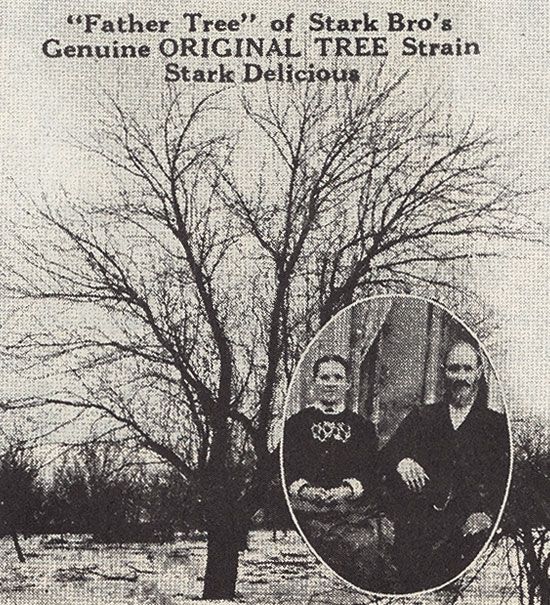
Hiatt received a gracious invitation from Stark Bro's Nurseries & Orchards Co. to send them samples for their novel New Fruit Fair. He enthusiastically packed up some of his Hawkeyes and shipped them off — along with some high hopes — to Missouri. (The fruit actually landed on William P. Stark's desk, and it is he who is credited by his brother Edgar for "discovering" the apple.)
On the day of the contest, five apples of each variety were put on plates and grandly displayed on long tables. The entry card was placed near each plate to identify the grower. It was quite a sight, all of those red, shiny apples. A seven-year-old boy was in attendance, marveling over the myriad of varieties. That little boy grew up to be Lloyd Crow Stark, the long-time chairman of Stark Bro's, and Governor of Missouri.
There was much animated discussion, some arguing and a lot of apple-tasting until the winner was finally announced: first prize went to the apples with finely-colored red and gold stripes, long, distinctive shape and five small bumps on the calyx end.
A good-looking apple to be sure, but it won for its exceptional flavor. The moment Clarence bit into one, he excitedly exclaimed, "My! This apple is delicious!" He paused, thought, and spoke again. "That will be its name! Who sent them?" The judges overwhelming declared the strange-but-delicious apple the winner.
But who had sent the apple? Chatter rose as the crowd speculated. To Clarence's great dismay, it became clear that no one knew who had sent the prize-winning beauties — the entry card was missing. Either the grower had failed to send it, or it had been carelessly lost. A frustrating, frantic search failed to bring it to light.
Meanwhile, back in Peru, Iowa, Jesse Hiatt was busy with his orchard. He never heard from the folks at the New Fruit Fair, and figured they must not have liked the shape of the Hawkeye, either. As a faithful Quaker, however, he refused to give up, and persisted in trying to get a taker for his unique apples.

Clarence knew he had to find the grower of this marvelous fruit. Its flavor was superior to anything he had ever encountered, and he despaired that it might be lost forever. He immediately sent letters to every grower who had entered the 1893 contest, urging them to send their best apples to the next Stark Bro's New Fruit Fair. Hiatt received that second invitation, and dutifully sent his long-and-bumpy apples to the Stark folks, along with a letter suggesting that they buy his tree.
Within five minutes of the fruit's arrival, the brothers knew they had been blessed again. The contest went on, but this time, there was little discussion and no arguing whatsoever. The winner of the 1894 International New Fruit Show: Hawkeye, grown by Jesse Hiatt of Peru, Iowa. There was an entry card, and with it, an enormous sigh of relief. The Delicious apple was saved for the world to enjoy.
Clarence was elated. He could not get to Iowa fast enough. The Stark brothers made the trip immediately and bought the sole rights from Hiatt, named the apple "Stark® Delicious" (only after naming 'Golden Delicious' in 1914 did it become 'Red Delicious') and secured a registered trademark.
The brothers could not wait to introduce their find to the public.
— Excerpt from 200 Years and Growing: The Story of Stark Bro's Nurseries & Orchards Co. by LeAnn Zotta, 2015
- Article Categories:
- History & Heritage

